Transform your home office into an eco-friendly haven with DIY energy-saving storage hacks. Repurpose old furniture like ladders and dressers for unique shelving, and maximize vertical space with floating shelves made from sustainable materials. Optimize natural light by positioning your desk near windows and using reflective surfaces. Switch to LED bulbs and smart lighting systems to reduce energy consumption. Create insulated storage containers from recycled materials, and set up a solar-powered charging station for your gadgets. Implement a paperless filing system to minimize clutter and waste. These simple yet effective solutions will help you create a sustainable workspace that's both stylish and efficient. There's so much more to explore in the world of eco-friendly office organization.
Repurposed Furniture Storage Solutions
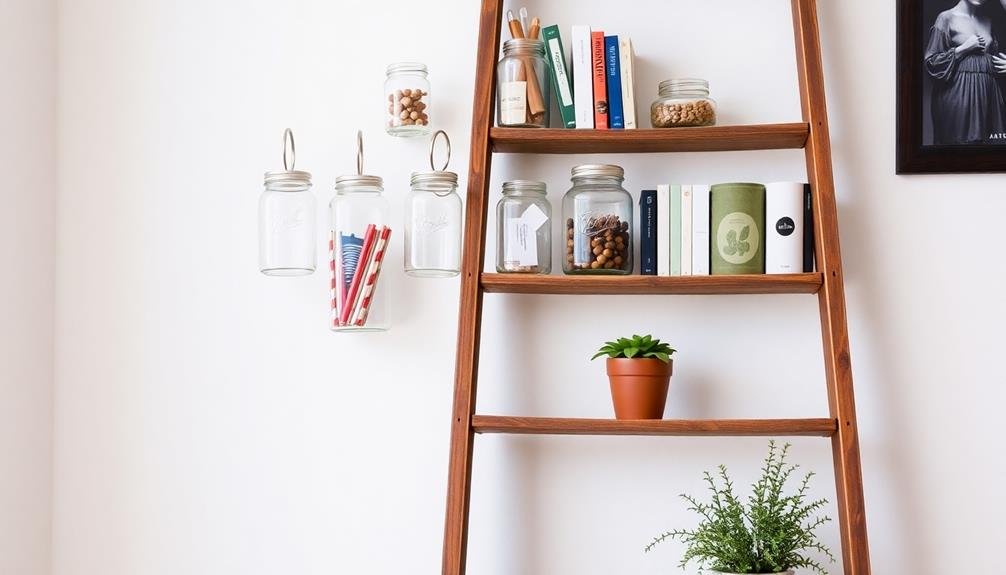
Three innovative ways to create eco-friendly storage for your home office involve repurposing existing furniture.
First, transform an old ladder into a vertical shelving unit. Simply secure the ladder to your wall and add wooden planks across the rungs to create shelves. This unique storage solution adds character while maximizing vertical space.
Next, convert a vintage suitcase into a stylish filing cabinet. Remove the lining, install hanging file folders, and add legs for stability. You'll have a portable, charming storage option that doubles as a conversation piece.
Lastly, repurpose an old dresser into a multi-functional office organizer. Remove some drawers to create open shelving, while keeping others intact for hidden storage. Paint it to match your decor and add custom hardware for a polished look.
These repurposed furniture solutions not only reduce waste but also add personality to your home office.
By thinking creatively, you can transform items you already own into functional storage pieces, saving money and reducing your environmental impact.
Plus, you'll enjoy the satisfaction of giving new life to old furniture while creating a unique workspace.
Vertical Space Maximization Techniques
While repurposing furniture offers creative storage solutions, maximizing vertical space can greatly expand your storage capacity in an eco-friendly way.
Start by installing floating shelves made from reclaimed wood or bamboo. These shelves don't require brackets, reducing material waste and providing a sleek look.
Utilize the full height of your walls by adding a floor-to-ceiling bookcase, which you can build using sustainable materials like recycled plastic or salvaged wood.
Don't overlook the back of your door. Hang an over-the-door organizer with pockets to store office supplies, reducing clutter on your desk.
For a DIY approach, create a pegboard system using FSC-certified wood. This versatile solution allows you to customize your storage with hooks, small shelves, and baskets as needed.
Make use of vertical file sorters to keep documents organized and easily accessible. Opt for ones made from recycled materials or create your own using upcycled cardboard boxes.
Natural Light Optimization Strategies
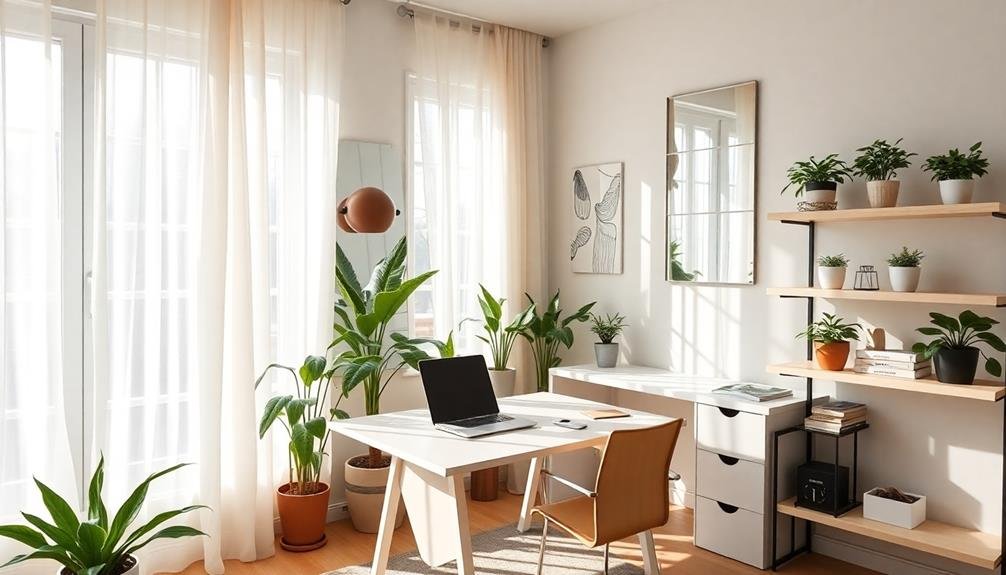
Optimizing natural light in your home office isn't just eco-friendly; it's a smart way to boost productivity and well-being. Position your desk near windows to maximize daylight exposure, reducing the need for artificial lighting. Use light-colored, reflective surfaces on walls and furniture to amplify natural light throughout the space.
Consider installing light shelves or reflective blinds to redirect sunlight deeper into your office. These simple additions can greatly increase the amount of natural light without causing glare on your computer screen. If privacy is a concern, opt for translucent window films that allow light in while maintaining discretion.
To make the most of natural light, organize your workspace strategically:
| Time of Day | Task Type | Lighting Strategy |
|---|---|---|
| Morning | High Focus | Direct sunlight |
| Midday | Routine | Diffused light |
| Afternoon | Creative | Indirect light |
When natural light is insufficient, supplement with energy-efficient LED task lighting. Place these fixtures strategically to illuminate specific work areas without overwhelming the entire space. By combining these techniques, you'll create an eco-friendly office that's both energy-efficient and conducive to productivity.
Energy-Efficient Lighting Options
Beyond natural light, incorporating energy-efficient lighting options is essential for an eco-friendly home office. LED bulbs are your best bet, consuming up to 75% less energy than traditional incandescent bulbs and lasting 25 times longer. Replace all your existing bulbs with LEDs to considerably reduce your energy consumption and carbon footprint.
Install smart lighting systems that allow you to control brightness and color temperature. These systems often come with motion sensors and timers, ensuring lights are only on when needed. You can also program them to mimic natural light patterns, supporting your circadian rhythm and boosting productivity.
Task lighting is another energy-saving strategy. Use desk lamps or under-cabinet lights to illuminate specific work areas rather than lighting the entire room. Opt for adjustable lamps that let you direct light where it's needed most.
Don't forget about light fixtures. Choose designs that maximize light output while minimizing energy use. Reflective surfaces and light-colored lampshades can help distribute light more efficiently.
Insulated Storage Container Ideas
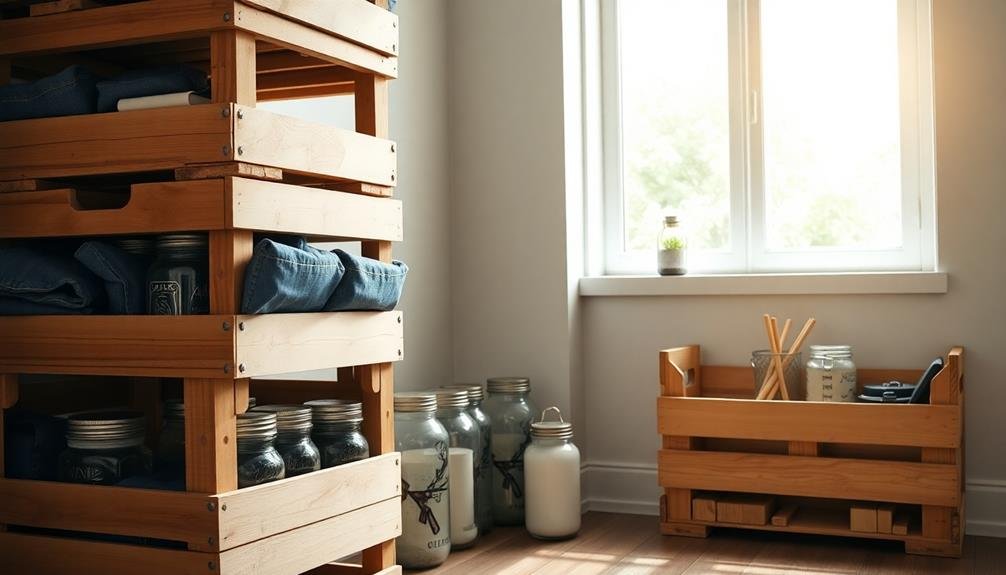
Insulated storage containers offer a smart solution for keeping your home office organized while maintaining energy efficiency. These containers help regulate temperature, protecting sensitive items from extreme heat or cold, which can be especially useful if your home office is in an attic or basement.
You can create your own insulated storage boxes using recycled materials. Start with sturdy cardboard boxes and line them with foam insulation boards. Cover the exterior with fabric or recycled paper for a polished look.
For smaller items, repurpose old coolers or insulated lunch bags as storage containers. Another eco-friendly option is to use natural insulators like wool or cork. Wrap storage boxes in wool felt or line them with cork sheets to create insulated containers. These materials are sustainable and biodegradable.
For electronic equipment storage, consider using old laptop sleeves or tablet cases. These often have built-in insulation and can protect your devices from temperature fluctuations. You can also create custom-sized sleeves using neoprene fabric, which provides excellent insulation.
Sustainable Material Storage Solutions
When it comes to sustainable material storage solutions, you'll find a wealth of eco-friendly options for your home office.
Look for storage containers made from recycled materials, such as repurposed plastic or reclaimed wood. These not only reduce waste but also add a unique aesthetic to your workspace.
Consider bamboo organizers for your desk drawers or shelves. Bamboo is a rapidly renewable resource that's both durable and stylish.
You can also opt for storage boxes made from recycled cardboard or paper, which are biodegradable and easily recyclable when they've outlived their usefulness.
For larger storage needs, explore furniture pieces made from sustainably sourced wood or reclaimed materials.
Bookshelves, filing cabinets, and storage ottomans crafted from these materials offer both functionality and environmental responsibility.
Don't overlook the potential of upcycling everyday items.
Transform glass jars into pen holders, use old wooden crates as shelving units, or repurpose tin cans as organizers for small office supplies.
These DIY solutions not only reduce waste but also add a personal touch to your home office.
Power Strip Organization Hacks
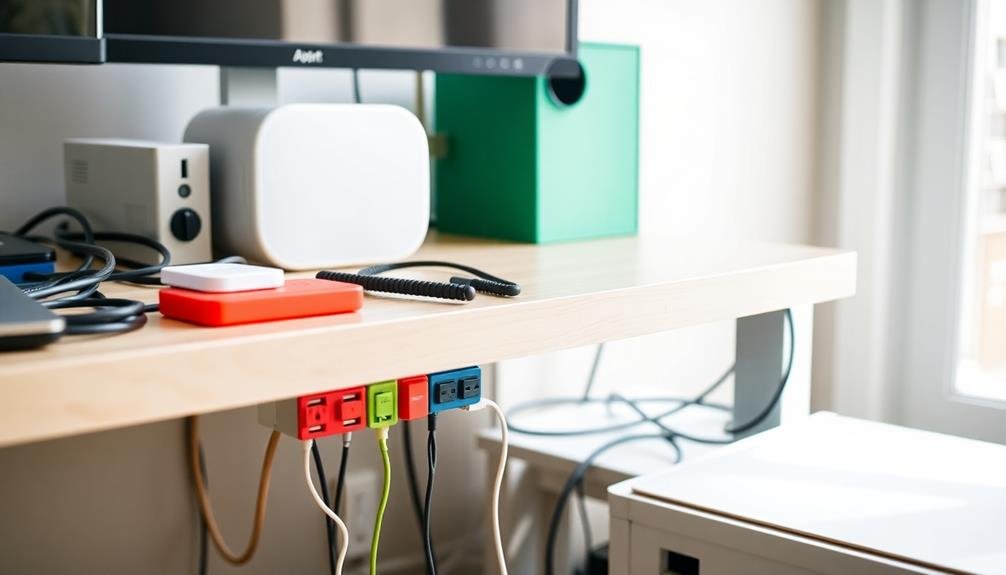
As you set up your eco-friendly home office, don't overlook the importance of power strip organization. Proper management of your power strips can reduce energy waste and create a cleaner, safer workspace.
Start by choosing energy-efficient power strips with surge protection and individual switches for each outlet. This allows you to easily cut power to devices you're not using, preventing phantom energy drain.
Place your power strips in easily accessible locations, such as mounted under your desk or on a nearby wall. Use color-coded labels or washi tape to identify which cord belongs to which device, making it easier to unplug specific items when needed.
Consider investing in cord clips or cable ties to keep wires neat and prevent tangling. For a DIY solution, repurpose binder clips to create cord organizers along the edge of your desk.
To further reduce clutter, opt for shorter power cords when possible or use cord wraps to manage excess length. Place power-hungry devices on the same strip, allowing you to switch them off simultaneously when not in use.
Paperless Filing System Setup
Embrace a paperless filing system to reduce clutter and minimize your environmental impact.
Start by implementing digital document management practices, scanning existing papers, and organizing files into a logical folder structure on your computer.
Utilize cloud storage solutions to guarantee your documents are securely backed up and accessible from any device, enhancing your workflow efficiency and reducing physical storage needs.
Digital Document Management
For a truly eco-friendly home office, digital document management is essential. Start by choosing a reliable cloud storage service like Google Drive, Dropbox, or OneDrive. These platforms allow you to access your files from anywhere, reducing the need for physical storage and paper consumption.
Create a logical folder structure that mirrors your paper filing system. Use descriptive file names and consistent naming conventions to make searching easier. Implement a regular scanning routine for incoming documents, using a high-quality scanner or smartphone app. Save files in PDF format for universal compatibility and long-term preservation.
Utilize optical character recognition (OCR) technology to make scanned documents searchable. This feature allows you to find information quickly without manually sifting through files. Set up automatic backups to protect your digital documents from loss or corruption.
Learn keyboard shortcuts and file management tricks to boost your efficiency when working with digital files. Consider using document management software for advanced features like version control and collaboration tools.
Cloud Storage Solutions
With cloud storage solutions, you can set up a paperless filing system that's both eco-friendly and efficient. By digitizing your documents and storing them in the cloud, you'll reduce paper waste and eliminate the need for physical storage space.
Choose a reliable cloud service provider that offers ample storage, robust security features, and easy accessibility from multiple devices.
To create an effective paperless filing system:
- Establish a consistent naming convention for your digital files
- Create a logical folder structure that mirrors your physical filing system
- Use tags or keywords to make searching for specific documents easier
- Set up automatic backups to prevent data loss
Scan existing paper documents using a high-quality scanner or smartphone app. Be sure to organize them as you go, following your established system.
For incoming documents, implement a process to digitize them immediately upon receipt. You'll need to invest some time upfront to set up your paperless system, but the long-term benefits are considerable.
You'll save space, reduce clutter, and have instant access to your documents from anywhere. Plus, you'll contribute to a more sustainable work environment by greatly reducing your paper consumption.
Eco-Friendly Cable Management Techniques
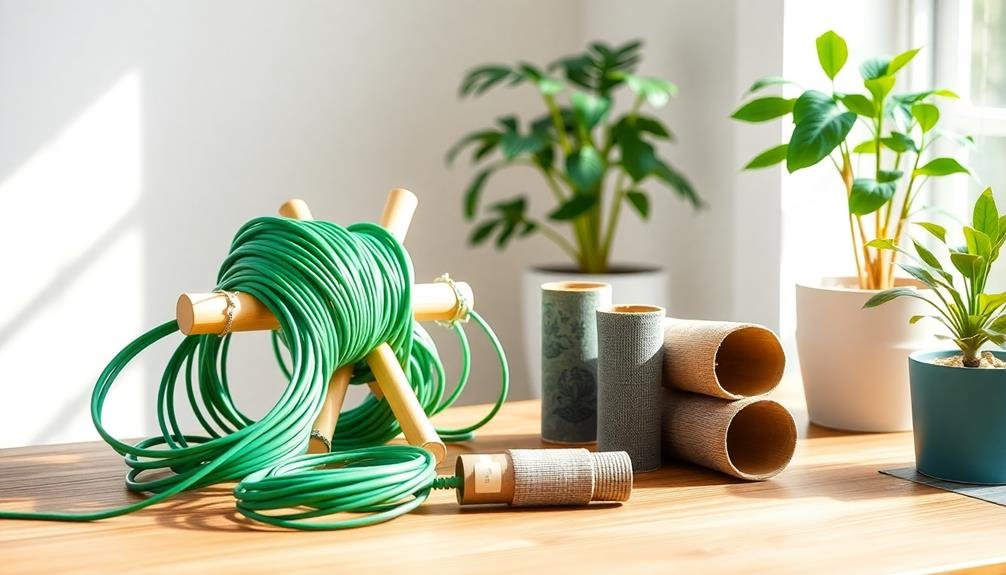
Taming the tangle of cables in your home office doesn't have to come at the cost of the environment. You can implement eco-friendly cable management techniques that not only organize your workspace but also reduce waste and energy consumption.
Start by evaluating your cable situation and eliminating unnecessary cords. Use wireless options when possible to minimize clutter. For the remaining cables, try these eco-friendly management solutions:
| Technique | Environmental Benefit |
|---|---|
| Cardboard tube organizers | Reuses household waste |
| Fabric cord wraps | Upcycles old clothing |
| Binder clip cable holders | Repurposes office supplies |
| DIY wooden cable box | Uses sustainable materials |
| Natural fiber cable ties | Biodegradable alternative |
Create a designated charging station using a power strip with an on/off switch to reduce phantom energy drain. Label your cords with reusable tags made from recycled materials to easily identify and unplug unused devices. Consider investing in smart power strips that automatically cut power to idle electronics, further reducing your energy consumption. By implementing these eco-friendly cable management techniques, you'll create a more organized, efficient, and environmentally conscious home office space.
Thermal Curtain Storage Designs
Thermal curtains' storage solutions can be both practical and eco-friendly in your home office. When you're not using them, you'll want to store them properly to maintain their insulating properties and extend their lifespan.
Consider creating a dedicated storage space that's easily accessible yet out of sight. You can repurpose old furniture or build custom storage units using sustainable materials. For instance, a reclaimed wood cabinet with adjustable shelves can neatly house your thermal curtains while adding a rustic charm to your office.
Alternatively, you might opt for a wall-mounted rod system that allows you to roll up and hang the curtains when not in use.
To keep your thermal curtains in top condition during storage, follow these tips:
- Use breathable fabric bags to protect against dust and moisture
- Avoid folding tightly to prevent creases and damage to the insulating layer
- Store in a cool, dry place away from direct sunlight
- Label each curtain set for easy identification and seasonal rotation
Solar-Powered Gadget Charging Stations
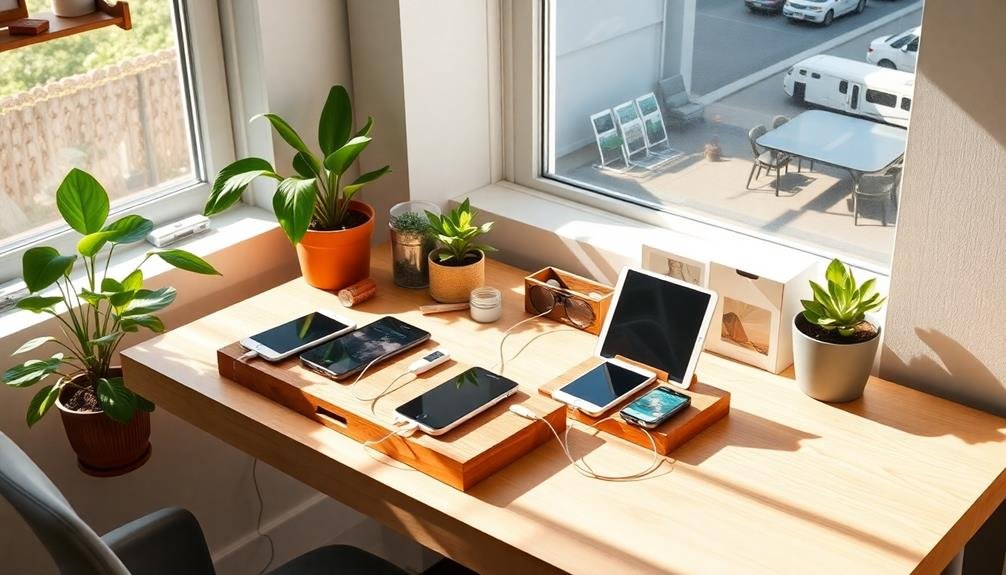
Solar-powered gadget charging stations offer an eco-friendly solution for keeping your devices powered up in your home office. These innovative storage solutions harness the sun's energy to charge your smartphones, tablets, and other gadgets without relying on grid electricity.
To create your own solar charging station, start with a small solar panel (5-10 watts) and a compatible USB charging controller. Mount the panel near a window or in a sunny spot on your desk. Connect the controller to the panel and attach a multi-port USB hub for charging multiple devices simultaneously.
Integrate this setup into your existing storage system by building a custom charging dock with compartments for each device. Use recycled wood or eco-friendly materials to construct a sleek, organized station that complements your office decor. Add labels or color-coding for easy device identification.
For added convenience, incorporate a battery bank into your solar charging station. This allows you to store excess energy for use during cloudy days or at night. Choose a lithium-ion battery pack with at least 10,000mAh capacity for peak performance.
Upcycled Storage Container Projects
In recent years, upcycled storage container projects have gained popularity among eco-conscious home office enthusiasts. These creative solutions not only reduce waste but also add a unique touch to your workspace.
You'll find that many everyday items can be repurposed into functional storage solutions with just a bit of imagination and effort.
Start by looking around your home for potential upcycling candidates. Old wooden crates, mason jars, tin cans, and even cardboard boxes can be transformed into stylish organizers. With a fresh coat of paint or some decorative paper, you can turn these items into eye-catching storage solutions that match your office decor.
Consider these upcycled storage ideas for your home office:
- Convert an old ladder into a vertical filing system
- Repurpose vintage suitcases as hidden storage compartments
- Transform wine crates into stackable desk organizers
- Use empty paint cans as colorful pencil holders
Energy-Saving Desk Organization Tips
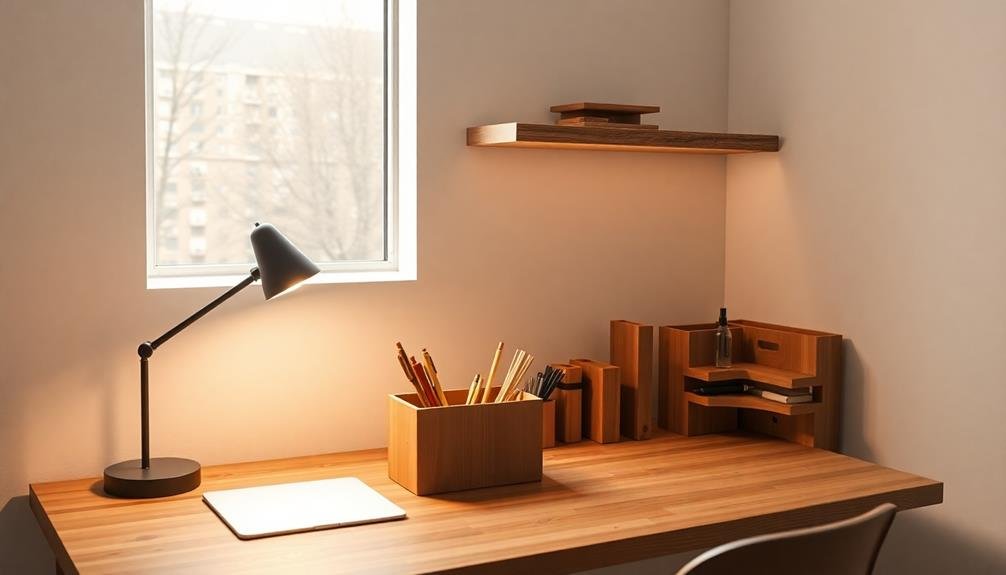
Organizing your desk with energy efficiency in mind can greatly reduce your home office's carbon footprint. Start by positioning your desk near a window to maximize natural light, reducing the need for artificial lighting during the day. Use LED task lighting for focused work, and opt for smart power strips to eliminate phantom energy draw from electronics when not in use.
Invest in a laptop instead of a desktop computer, as they consume less energy. When choosing office supplies, prioritize rechargeable batteries and refillable pens to minimize waste. Implement a paperless system by digitizing documents and using cloud storage, reducing the need for energy-intensive printers and physical storage solutions.
| Energy-Saving Tip | Benefits | Implementation |
|---|---|---|
| Natural lighting | Reduces electricity use | Position desk near window |
| LED task lighting | Lower energy consumption | Replace old bulbs with LEDs |
| Smart power strips | Eliminates phantom energy | Connect all devices to one strip |
Frequently Asked Questions
How Can I Soundproof My Home Office for Better Concentration?
You can soundproof your home office by installing acoustic panels, using heavy curtains, sealing gaps around doors and windows, adding a white noise machine, and placing rugs or carpets to absorb sound. These methods will greatly reduce noise disturbances.
What Are the Best Plants for Improving Air Quality in a Home Office?
You'll find that snake plants, spider plants, and peace lilies are excellent for improving air quality in your home office. They're low-maintenance and effective at removing toxins. Don't forget about aloe vera and rubber plants too!
How Can I Create an Ergonomic Workspace Without Spending Too Much Money?
You can create an affordable ergonomic workspace by adjusting your chair height, using a laptop stand, and adding a keyboard tray. Invest in a supportive cushion, utilize DIY footrests, and position your monitor at eye level for comfort.
What's the Ideal Temperature Setting for an Energy-Efficient Home Office?
You'll find the ideal energy-efficient temperature for your home office is 68°F (20°C) in winter and 78°F (26°C) in summer. Use a programmable thermostat to maintain these settings and adjust when you're away or sleeping.
How Can I Incorporate Biophilic Design Elements Into My Home Office Storage?
You can add biophilic elements to your home office storage by using natural materials like bamboo or reclaimed wood for shelves. Incorporate plants into your storage solutions, use nature-inspired colors, and display organic shapes in your organizational items.
In Summary
You've now got a toolkit of eco-friendly storage solutions for your home office. By repurposing furniture, maximizing vertical space, and optimizing natural light, you're well on your way to a greener workspace. Don't forget to implement energy-efficient lighting, insulated containers, and thermal curtains. With solar-powered charging stations and upcycled storage projects, you'll reduce your carbon footprint. Remember, even small desk organization tweaks can lead to significant energy savings. Embrace these DIY hacks and watch your eco-friendly office come to life!

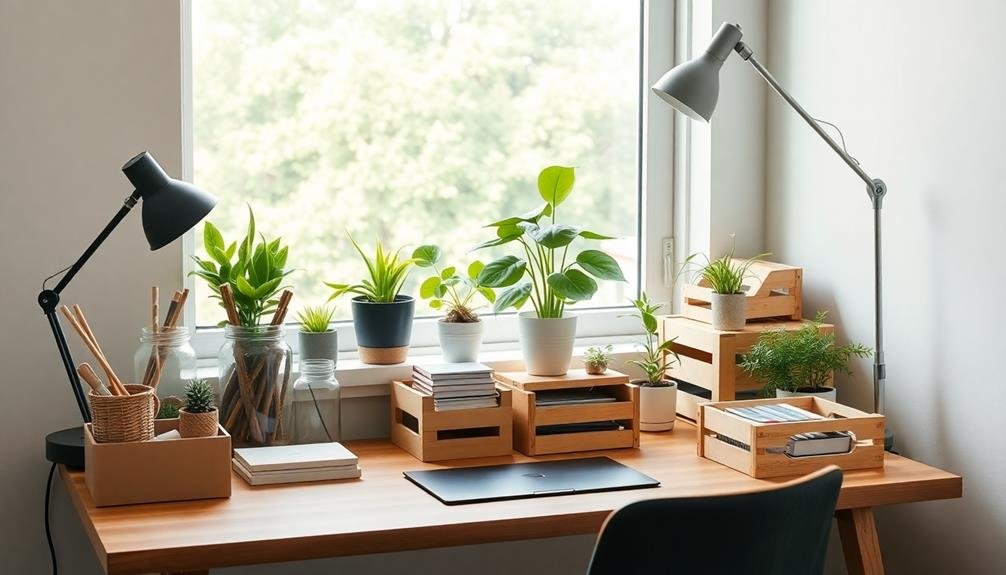
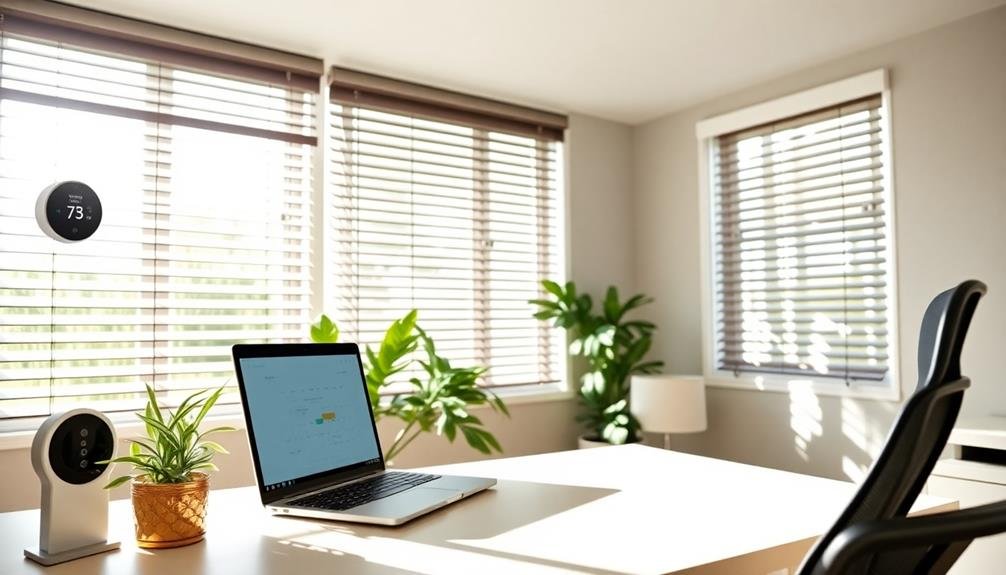
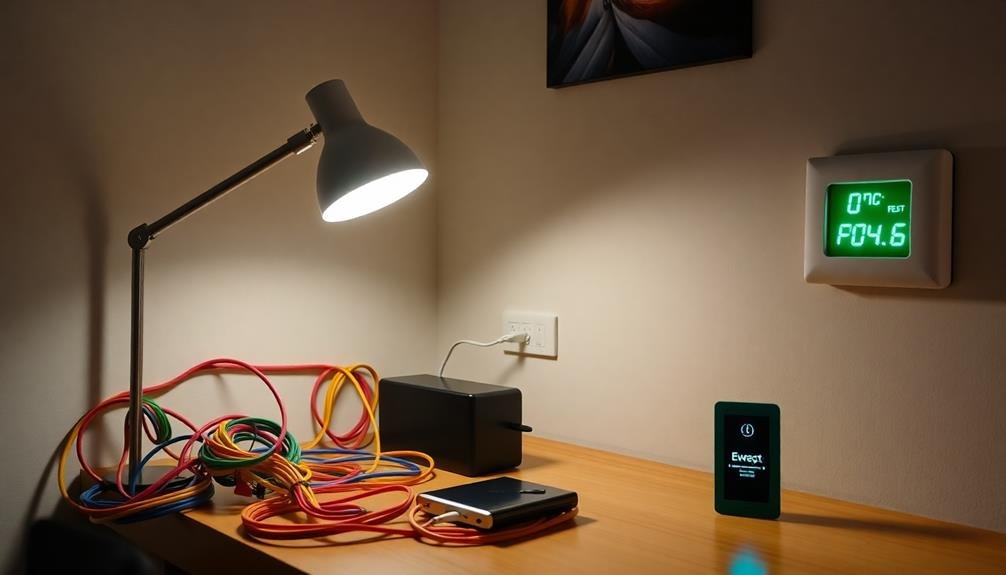
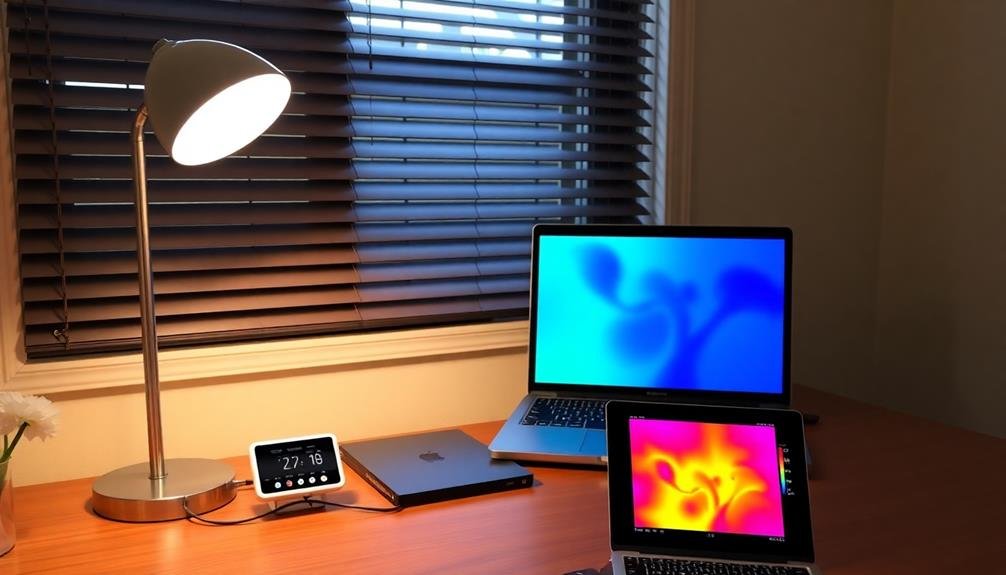
Leave a Reply